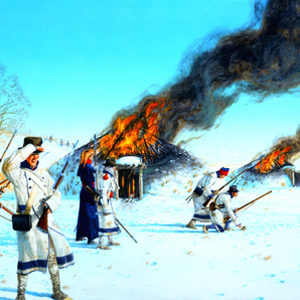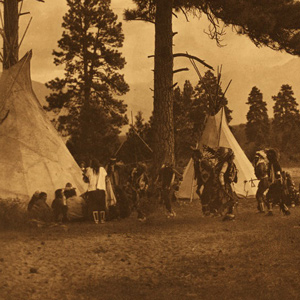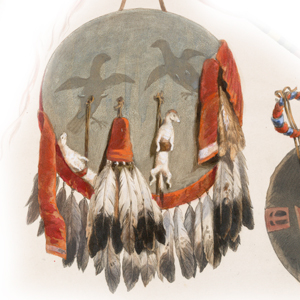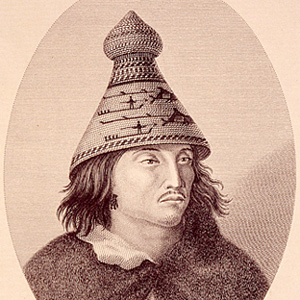“Lewis and Clark left St. Louis filled with apprehension about encounters with hostile Indians. But what emerged over nearly two and half years of western travel was an atmosphere of friendship and mutual trust between men and women who shared a common frontier life.”
Meriwether Lewis was to answer a long list of questions about the American Indians they encountered. They were to inform each nation that there was new “American Father” who would protect them and trade with them. They were to establish peace among warring tribes and change established trade relationships with European companies. They would often rely on the Native Nations to guide them and to simply survive. They would need to employ all the diplomatic skills they possessed.
Selected Pages with Diplomatic Encounters
January 10, 1806
Šax̣awaq̀ap visits


After an early start at the salt makers’ camp, Clark hikes and canoes well into the dark to return to Fort Clatsop. During the day, a dozen Kathlamets visit Lewis and elk become scarce.
August 21, 1806
At the Arikara villages


At the Arikara villages above present Mobridge, South Dakota, several councils are conducted between various Mandans, Arikaras, and Cheyennes. One of their 1804 engagés shares ominous news.
September 23, 1805
Nez Perce council


At the Weippe Prairie Villages, the captains hold their first Nez Perce council with a message of “peace and good understanding”, and trading commences. Lewis and two others are sick.
November 21, 1805
Clatsop and Chehalis visitors


At Station Camp near the mouth of the Columbia, some Clatsops and Lower Chehalis visit, and the wife of Chinook chief Delashelwilt brings six young females to camp. Clark describes Chinookan woven hats.
October 10, 1804
An Arikara council


At Sawa-haini above present Mobridge, South Dakota, a council with the Arikaras is held. The standard speeches and gifts are given, Lewis demonstrates his air gun, and York hams it up for the locals.
March 9, 1805
Grand Chief Le Borgne


Le Borgne pays his first visit to Fort Mandan where the captains try to impress this important Hidatsa chief. Despite Lewis’s efforts, he leaves with disdain for all except the blacksmith and gunsmith.
March 22, 1805
Man Wolf Chief visits


At Fort Mandan, Man Wolf Chief of Menetarra is given the standard diplomatic treatment: an Indian peace medal, gifts, and a speech. Engagé François Rivet comes for his canoe.
December 12, 1805
Coboway's peace medal


Two canoes of Clatsops come to the construction site to trade wapato and a sea otter skin. The captains give a medal to Chief Coboway, and Clark describes the Clatsop’s desire for blue beads.
February 16, 1805
Scorched earth


Many miles south of Fort Mandan and the Knife River Villages, Lewis and his soldiers continue their pursuit of a Sioux war party. They come to an old Mandan village where two lodges have been set afire.
November 28, 1804
Black Cat's medals


On this snowy day at Fort Mandan, Posecopsahe—Black Cat—comes to see the American “Curiossities.” He is told to no longer accept peace medals or flags from trader François-Antoine Larocque.
August 3, 1804
The Otoe council


Most of the day is spent exchanging speeches, gifts, and knowledge with the Otoes and Missourias on Council Bluff at present Fort Atkinson, Nebraska. Then, the boats travel six miles up the Missouri.
October 19, 1805
The Walla Walla and Umatillas


After passing Hat Rock in the Wallula Gap, Clark frightens several Umatillas who—after seeing Sacagawea—learn he is not part of a war party. The day ends with mutual smoking and fiddle music.
September 25, 1804
Good humor left behind


At Good Humor Island at present Pierre, South Dakota, a council with the Lakota Sioux brings diplomatic speeches, a military parade, and gifts. When the captains try to disembark, weapons are raised.
December 2, 1804
A Cheyenne delegation


When four Cheyennes arrive at Fort Mandan, the captains give them a speech, tobacco, a flag, and demonstrations of many ‘curiosities’. They also give them a letter of warning for the Sioux and Arikaras.
The Osage Delegations
by Joseph A. Mussulman

They were “certainly the most gigantic men we have ever seen,” Jefferson wrote on 12 July 1804. A dozen Osage men and two boys had arrived in Washington City the previous day, escorted by Pierre Chouteau.
May 11, 1806
Council at Lawyer Creek


Lawyer Creek near Kamiah, ID With four major Nez Perce chiefs present, the captains continue their council at Lawyer Creek. After that, they demonstrate the air gun and magnets; and provide medical aid to several applicants.
September 5, 1805
Flathead Salish council


At present Ross’ Hole, Montana, a council with the Flathead Salish is held using five different languages: Salish-Shoshone–Hidatsa–French–English. Gifts are exchanged, and then horse-trading commences.
Flag Presentations
by Joseph A. Mussulman

Lewis and Clark usually distributed flags at councils with the chiefs and headmen of the tribes they encountered—one flag for each tribe or independent band.
August 30, 1804
Yankton council and dance


At a council with the Yankton Sioux, Lewis delivers a speech, gifts given, and a peace pipe passed. Clark learns about the Akicita Society, and Sgt. Ordway finds their musical instruments interesting.
December 29, 1805
Wahkiakum traders


Clark gives visiting Wahkiakum traders a small peace medal and ties a red ribbon to a cone hat; Clatsop chief Coboway is given a razor. Clark also lists the day’s work details and sick men.
November 20, 1804
Sioux threats


At Fort Mandan below the Knife River Villages, Charbonneau brings in a large load of meat and furs, and the captains move into their quarters. Three chiefs from Ruptáre bring news of a Sioux threat.
March 29, 1806
Nahpooitle Village


They paddle fifteen miles up the Columbia and encamp near present Ridgefield, Washington. The captains describe the dress, houses, wapato trade, and customs of the Nahpooitle (Cathlapotle) villagers.
August 19, 1804
Otoe's council, Floyd's illness


During a council at Fish Camp near present Homer, Nebraska, speeches with the Otoes are exchanged, but they appear dissatisfied with their gifts. Sgt. Floyd becomes seriously ill requiring urgent care.
October 16, 1805
A musical welcome


The paddlers negotiate the last of the Snake River rapids and the expedition arrives at the Columbia River. Soon after, they are given a musical welcome from a large group of Yakamas and Wanapums.
Experience the Lewis and Clark Trail
The Lewis and Clark Trail Experience—our sister site at lewisandclark.travel—connects the world to people and places on the Lewis and Clark Trail.
Discover More
- The Lewis and Clark Expedition: Day by Day by Gary E. Moulton (University of Nebraska Press, 2018). The story in prose, 14 May 1804–23 September 1806.
- The Lewis and Clark Journals: An American Epic of Discovery (abridged) by Gary E. Moulton (University of Nebraska Press, 2003). Selected journal excerpts, 14 May 1804–23 September 1806.
- The Lewis and Clark Journals. by Gary E. Moulton (University of Nebraska Press, 1983–2001). The complete story in 13 volumes.

